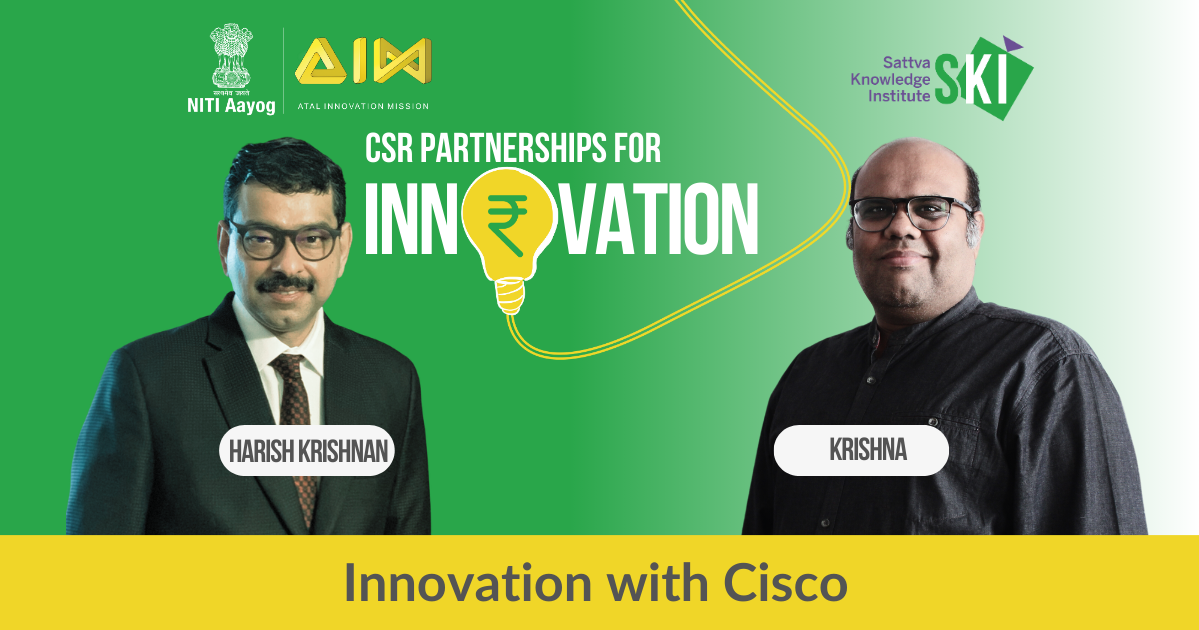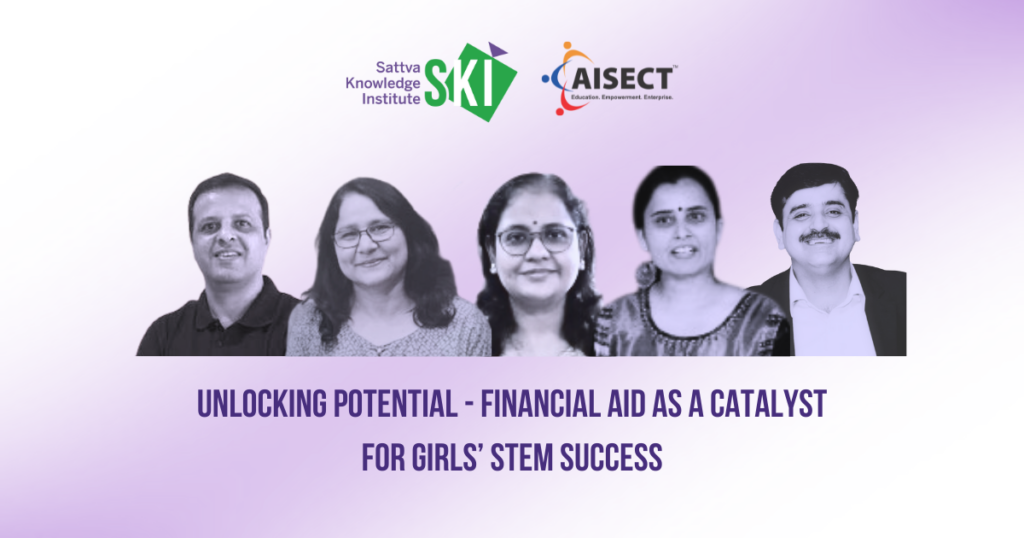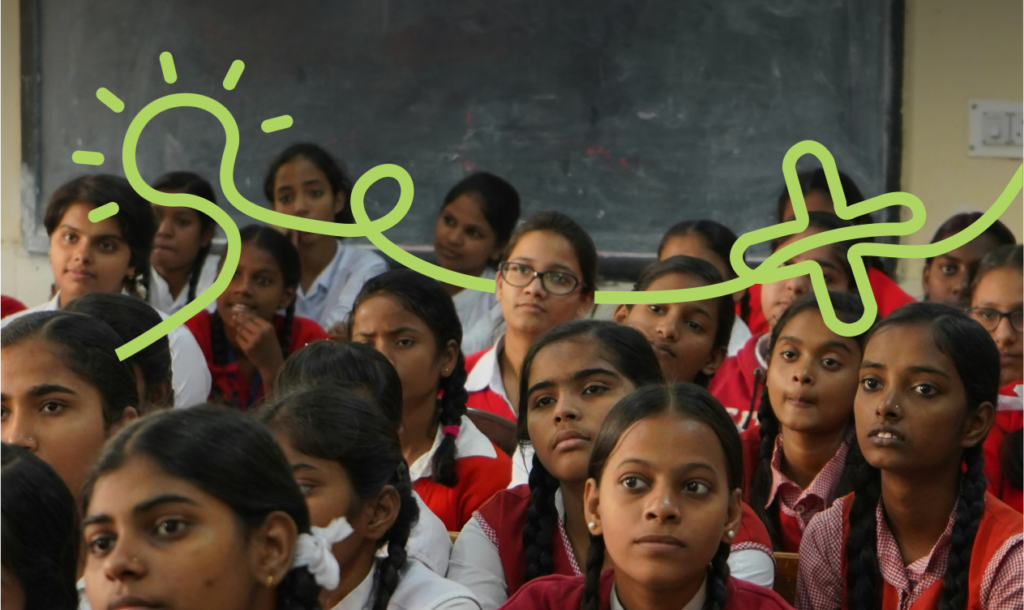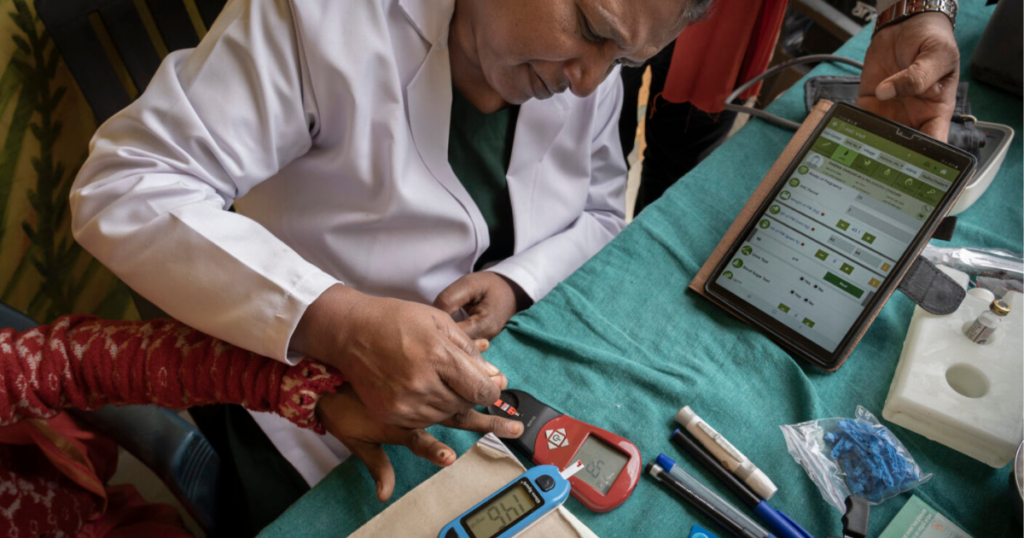


CSR spending in India is concentrated in a few sectors, including education and healthcare. Less than 1% of the CSR funds are channelled towards incubators to support social enterprises. To understand the criticality of CSR backing for scalable and impactful solutions through social enterprises, we have with us today, Mr. Harish Krishnan, Managing Director, Public Affairs and Strategic Engagements at Cisco India and SAARC. Harish leads Cisco’s strategic engagement with India’s national and state governments on a wide range of public policy issues that concern Cisco in India.
Episode Transcript
Introduction: Welcome to the podcast ‘CSR Partnerships for Innovation’. I am Chintan Vaishnav, Mission Director for Atal Innovation Mission at the Niti Aayog, and we are delighted to unveil this podcast series in collaboration with Sattva Consulting, hosted by their dynamic and hands-on CEO Srikrishna Sridhar Murthy. We are excited to embark on this journey with you as we navigate the fascinating realm where innovation meets CSR. So, thank you for tuning in, hope you enjoy it.
In a world driven by innovation and fuelled by entrepreneurial spirit, India has emerged as a vibrant hub for cutting-edge ideas and groundbreaking initiatives. From villages to large metropolitans, the country is witnessing a remarkable surge in start-ups and innovation-focused ventures across diverse sectors. Innovation, when channelled properly, can create a large-scale societal impact. India has also been home for one of the most active CSR ecosystems, thanks to the regulation in CSR that was introduced a few years ago. We believe CSR can play a very important role in fuelling the innovation towards societal change and we hope to explore how the CSR ecosystem and the world of innovation are coming together to build a better India.
Srikrishna Sridhar Murthy (SM): [00:01:40] So starting off, Harish, firstly, thanks a lot, really wonderful to have you as part of this podcast today and looking forward to the discussion and understanding Cisco’s journey in CSR, and also how Cisco has managed to engage quite deeply in the entrepreneurship innovation research ecosystem through the CSR investments. It’ll be great, Harish, if you can quickly introduce yourself, your role in Cisco and more importantly, your engagement with the CSR ecosystem in Cisco and outside as well.
Harish Krishnan (HK): [00:02:12] Thank you Krishna. Happy to participate in this podcast. I’m actually part of the global government affairs organisation of Cisco. I’ve been in Cisco for over 16 years. I’m the managing director and chief policy officer of Cisco India. So when you work in global government affairs organisation, you work a lot with the government both at the central and the state level in in policy, and one of the basic training that we get for any good public policy professional is to think of the country first, then the industry and then the company, because for you to get a seat on the table in any policy making body, you need to be relevant to the society that you come from. Which is why, you know, it is so important for people in my role to be connected to society in a big way, and this is also a personal passion for me. So, it is natural for me to, you know, kind of evolve and move into Cisco CSR activities from the very beginning and almost from the time I joined Cisco India 16 years ago. One of the interesting things happened – Cisco’s purpose is the company is to power an inclusive future for all. I always reiterate that it is not a Cisco CSR mandate or purpose. It is a purpose of the company, which is the reason why Cisco, as a company, exists to power an inclusive future for all. And a couple of years ago, Cisco did a restructuring and brought the people policy and purpose organisation under one roof and we call it the 3P organisation. And this function reports to the Chief People Policy and Purpose officer globally. So, this works the synergy between policy and purpose got together even institutionally. So that got me even more drawn into the CSR programme.
SM: [00:04:04] I really like the country first kind of an approach, which I think is quite inspiring, and the ability to kind of bring the three Ps together. Harish, kudos on that. Just would be great to also get a sense of how CSR has evolved in Cisco. The law also has gone through a lot of transition. How did Cisco start kind of where does Cisco stand today and what has been the evolution like and key milestones if you were to kind of talk about that?
HK: [00:04:30] So Cisco is all about connecting people, connecting things, and we believe when you connect the unconnected magic happens, and we have been implementing CSR long before the 2% mandate came into being in India. I remember soon after I joined Cisco, there was this big flood in Karnataka and the government approached all the companies, they asked them to, you know, build 100 homes and so on and so forth. Cisco built 5000 homes in Rajkot, right? This is like way back in 2007 before the mandate came. But I think the biggest example of a corporate social responsibility going beyond any mandate at Cisco NetAcad, the Cisco Networking Academy, which was conceived 25 years ago and is a global flagship programme of Cisco, and over the last 25 years, Cisco has trained 17 million students in networking skills and, you know, and 3.2 million in the last one year, and India has been one of the areas where NetaAcad has really grown in the last few years. To just give you an example, we have trained about a 1.2 million people since inception, but the last one year alone we have done 400,000. So that’s kind of scale that we’re doing. So again, another example of why we didn’t wait for the government to mandate. But when this whole India cash grant programme came in, this whole mandate came seven, eight years ago, this mandate came. So since then, I think obviously we have implemented the India Cash grant programme. Initially it was like, you know, a bunch of Cisco people coming together doing good, they’re like, you know, we had the Cisco Civic Council, which would, you know, consist of a lot of Cisco employees who would come with different programmes, and then what we discovered was while we were supporting a lot of noble causes, it was not quite adding up. Right? So, it was like a little all over the place, and therefore, to get better impact, we decided to have a theme for our CSR, which is when we zeroed in on the three themes of education, economic empowerment, and critical human needs. There are three themes – that was the second stage of the evolution. Then we thought about this more and said, “Look, you know, again, what we are doing was to do again, a lot of good activities, these three themes, but probably in a bit disparate fashion, we might be doing like glass for education in Meghalaya. We’re doing something in the Karnataka government and education in here, something else in Kerala, and so on and so forth.” Which is when we decided let’s kind of go evolve further and make this whole thing programmatic and get it into the intersection of technology and social impact. So that’s when we even started, you know, looking at co-branding some of our programmes, and we essentially kept the same three themes but added three filters to it. Obviously, the first filter is being socially relevant. The second one is to ensure that we have scale, and the way we ensure we have scale is by government partnership and through technology.
HK: [00:07:23] Finally, it had to be financially viable and replicable, and we’ve got numerous examples of programmes that we have done which clearly showed great impact. I would like to pick two, for example, the Cyber Suraksha programme that we are partnering with NIIT Foundation and where we made a commitment to train a million underprivileged individuals in cyber security by the year 2025. Of these, we have already completed 200,000, and we envision 40% of the impacted beneficiaries will be women, and as you know, cyber security is becoming extremely important. You know, as more and more Indians are getting connected, we always say in Cisco, when something is connected, it has got to be protected. These individuals are not just students who are aspiring to be cyber security professionals. It could be, you know, middle aged people, old people, very young people, anybody who is in the net, and I think this is, again, something that we are doing in partnership with the government and I think we are seeing great results. The second example is Cisco Incubator. It is a network of maker spaces and spread across 30 universities, where students learn on digital technology in a hands-on environment. The idea is to create prototypes, create local solutions for local problems, and till date, we have had 402,000 students in this programme and 2000 plus ideas, and 31 of these ideas have, you know, progressed into incubators, you know, like Start-Ups, which have been incubated out of this.
SM: [00:08:56] So that’s wonderful. I think the evolution from responding to some of the issues, like the floods, to then having a structured focus on certain key areas like education, economic empowerment, and critical human needs to eventually moving to a very programmatic kind of focus and then seeing the three criteria also of scale, replicability and obviously being socially relevant. I think all of them kind of resonate very strongly of the core purpose of CSR – think how CSR can add value. How did this focus on innovation or entrepreneurship kind of come into the discussion? I’m sure you’ve been part of the CSR committee for a for a long time. You’ve had a lot of discussion with your peers at the committee, and you’re one of the few CSRs who have a very strong focus across your portfolio on innovation, technology and looking at scale because of technology type of stuff. So, when did that thought kind of come in that you transitioned from doing more one-off projects to thinking in this strategic way about innovation? What were some of the discussions like in the CSR committee? Was there some urgency or resistance, or was it smooth to say, hey, this is anyway something we should do as a tech company? What were those conversations like?
HK: [00:10:08] Yeah, I think Krishna, clearly India plays 1.4 billion people, so it needs scale to make any impact. I think the good news is that India’s digital infrastructure has come a long way since the time we began this journey, and I think we are at a cusp of where we have affordable internet technology and the affordable cost and, you know, very innovative people, both people who are innovators as well as consumers of innovation. We find both in India and I think before, like Cisco, as a technology company, innovation is a natural bias for us, and when combined, these factors made it somewhat easy for us to lean towards innovation. We also recognised that CSR funding is perhaps the highest form of risk capital in some sense. Right? So many times, what happens in conversations with leaders in the government. Let’s take education for example. Right. So, I’m sure the union budget must be some 90,000 crores or something like that. So maybe higher secondary education or something like that. And if you look at the total CSR budget of the country, is it 8000 crores or something like that, 26,000 crores? Okay, so I’m saying one problem, one subset of a problem. The government has got 90,000 crores and that is underfunded. Right? And then look at the CSR funding of the country is so low. So, there’s no way that CSR is going to solve all this. You know big challenges by themselves. But what the CSR managers can do is to take risks and do proof of concepts and show what can work, and you know, it’s not only about technology, it’s about business models that will work and that can then take advantage of this higher funding that the government has, because the government obviously has many guardrails and obviously, they cannot spend money on high-risk kind of activities. So, number one is that is one of the important things. Secondly, what we are also trying to do is to not only fund innovators but create innovators. We look at incubator, for example. It is a story where we are getting students to think innovation, think entrepreneurship right, and move away from trying to be job seekers, to become job creators, and frankly, that is what is going to make India the third largest economy in the world when young people become entrepreneurs and innovators. So, I think that is what we are trying to do in our own small way.
SM: [00:12:33] CSR as risk capital is one of my favourite lines of the conversation today, because I think that really sets the mindset of CSR very, very differently, and to look at solutions which are more forward-looking than just looking at what exists today, because some of the problems are also, we are trying to catch them as we are solving them, and that won’t be possible if you only use today’s solutions. You also need tomorrow’s kind of solutions in some form to come together. So really love that thought process. In terms of the conversations from a Cisco perspective, have there been discussions on some of the challenges of funding innovation and entrepreneurship using CSR? It’s probably one of the right things to do. It’s also harder to measure. It’s hard to kind of figure out, is it working, not working when, let’s say building homes or giving books to children or building a school or it’s a little more tangible in some form, but funding innovation, funding entrepreneurship, where there’s a bit of risk or more long-term impact, is it harder to kind of define some metrics? Has there been discussion within Cisco as well saying, “Hey, I know we are going in this path, but are we on the right path?” What do we kind of measure?
HK: [00:13:38] Yeah. So, I think there’s always in any discussion a risk-reward ratio. One takes into consideration and we try to keep a balanced portfolio. We have made a commitment to impact 50 million lives by the year 2025, and that’s a hard commitment, right? So just as the business is measured on our revenues, we have equally strong metrics for measuring impact, [00:14:00] so we keep an eye on that so that we don’t get carried off too much on one side. So, we have a mix of some regular projects that we do which are tangible, which we can see the rise and innovation. And again, we keep a hawk-eye on that so that we don’t get too carried away. So, like I said, we always look at government partnerships. What I mean by that is it’s not like we do something and go to the government after that and say, look, we’ve done something. It is co-creation along with the government. You go and tell the government, look, this is what we’re trying to do. This is a solution that we are trying to apply.
HK: [00:14:31] Are you with us? You know, we’re not asking for any money, but saying, look, are you participating in this? Right? And when succeeds, is there, you know, a propensity to adapt what we’ve taken? So those are important criteria for us. So, government ownership is very important. Like sometimes we used to have this phrase called NCNC – like the government no cost, no commitment. Like if they say, okay, go do something and you know, frankly, there’s no skin in the game, right? So, to speak here you know, we try and involve the government, not so much directly, but for example, in our Cisco Agri challenge, we always have a government, remember, right, as part of the process. So, the person knows what we’re trying to do, and they also got exposure to the entrepreneurs and the innovators who are on the job. So, I think these are ways by which we try to de-risk and also maximise impact where we succeed, and luckily, we’ve been fairly successful in a number of things that we’ve done in this space.
SM: [00:15:27] So that’s two interesting points there. One is having a matrix internally like the number of people we’re impacting. But also I think one of the things that I’m hearing you say is that the feedback loop with the government who partners with you is also a great metric to kind of figure out whether there’s impact or not because if you’re able to get the NCNC from a government where you are able to kind of partner and co-create, that’s actually an interesting validation of whether we are solving the right problem and the impact is being created as well. So, I think that’s quite interesting to note. What I kind of, especially in NIIT the example that you talked about on the cybersecurity bit, I see a lot of Cisco in the programme. It’s not just a nation India problem. There’s a little bit of a Cisco in that in terms of the skills you bring, the products you bring, the thinking you bring. Is that something that you look to add value beyond money? We do have the risk capital that is coming in. And you just talked about 26,000 crores of CSR money, but 26,000 crores plus the intellect of the corporate sector or the technology of the corporate sector or the thinking of the corporate sector is much more valuable than 26,000 crores in itself. Cisco kind of brought in a little more than money into these programmes and how that partnership has worked. Any examples?
HK: [00:16:39] Yeah. So, I think what we’ve done is we have obviously kept business and CSR separate, right? We don’t mix it up much, but that doesn’t mean that we don’t bring our domain expertise to something where we can weigh in. Cybersecurity is a very good example. Cisco cybersecurity expertise is the top end of the business. But creating a cybersecurity awareness is something that we try to do through CSR. You know, the skills development is what we try to do through CSR, right? So, I think we don’t kind of mix up the business objective and the CSR objective, but then try and bring in our domain competence to weigh in on the whole value proposition, and there have been examples that we’ve done a project in Assam on health care, where, you know, certain Cisco equipment has been used to deliver telemedicine, but those are not from Cisco CSR. It’s from another bucket of innovation that we have in Cisco, where we use the CSR money to fund the project management of that particular programme. So again, we try and mix and match. In fact, one of the things that we’ve done in India is, like I said, we’ve our purpose is to power an inclusive future for all, and that is not a Cisco CSR purpose, but a company purpose. We are set up something called a Cisco Purpose Office in India which has got CSR Network Academy, there’s something called the Country Digital Acceleration Programme of Cisco, which is the technology evangelisation programme. We’ve got our sales team, our engineering team, everybody come together under this office where we come together, and the first level you talk about the various things that we do. Sometimes in a large company, you know, it’s difficult for the right hand to know what the left hand is doing. The first thing is to get everybody to know, you know, what we’re doing. Second is to look for synergies between these activities. And third is to kind of conceive programmes together with, you know, a little bit of everything so that it is not a siloed activity, and we bring one Cisco to the table.
SM: [00:18:25] That’s wonderful, Harish, and also, I know you have a very large employee base, I mean your domain expertise is clearly of great value to solve societal problems. But you also have a fairly large amount of workforce in India who also have skills and potentially time to contribute to both the CSR programmes and some of the other societal challenges that are out there. So is there convergence between employee engagement, volunteering, and some of the innovation work that you do in terms of mentoring, coaching these entrepreneurs or in incubators and things like that? Any examples of that?
HK: [00:18:57] To employee engagement is at the heart of Cisco CSR strategy. It is one of the things that we take into consideration when we decide what we do and where we do a project. We always look for a critical mass of Cisco population in the area who can get involved, and what’s amazing is that Cisco’s average age of a Cisco employee in India is, I think, you know, the mid to late 20s, right. Therefore, what we do is to engage them, involve them at multiple stages, right. At the stage of conceptualisation, for example, incubator was conceived by our engineering organisation. It is inside a programme which is inside Cisco, which we kind of took it out. And secondly, about the Cisco Agri challenge, which I mentioned, which is about doubling farmer income. And we had a whole bunch of people from Cisco’s Digital Transformation Office, from the engineering organisation participate in this whole process of shortlisting 800 applicants to the final 5 or 6 applicants. And I think a whole lot of mentoring and mentoring is not just one way mentoring. It happens two ways. The Cisco employee also gets mentored. The beauty of this is that, frankly, we might have expertise in technology but have no expertise in agriculture. So, when you kind of work with these entrepreneurs or get exposure to farmers, etcetera, our own agri solutions become better, right? We’re not talking academically about something up in the air. So, I think it is a two-way mentoring. Many times, there’s to make a short point. Employee engagement is absolutely at the centre of the CSR programme that we have. We have employees volunteering. Our employees used to participate in some of these activities. So, we’ve got a bunch of very forward-looking programmes which encourage employees to participate in social projects.
SM: [00:20:36] That’s extremely useful. I think we’ve also seen that the value multiplies significantly when we bring the financial capital and human capital together. I think that’s really the core objective of CSR. Any example where you’ve funded the agri challenge, a lot of the incubators you work with, some of the other innovation ecosystems. I know ISE is something that you work with also very closely. Any of the actual innovations Harish is your favourite, where you saw a particular technology or a particular start-up or a particular innovation where you said, “Oh wow, thank God we are doing this kind of work in our CSR” – type of stuff, which got you excited.
HK: [00:21:15] There are many, many such examples. In fact, one thing that actually gives me a lot of satisfaction is to see a lot of young people in this space who come with so much of concern for society. I would think that this generation is so much more socially conscious than perhaps my generation, and they’re willing to take this risk, right? So, great to interact with the young people. I think Cisco Agri Challenge is one of my favourites. So, like you said, they partnered with Nudge to create the programme, and we declared a prize money of two crores. And we had a process of 18 months to shortlist from 800 applicants to the final one. So, it is not about the one winner who took it away, but it is also the 18-month process and the 18 applicants and the interaction that we had. But that one winner was somebody that impressed me a lot, you know, from S4S Technologies and the innovation that she had when growing up. We always heard about these losses from farm to fork, and we always used to rue about, you know, lack of cold chains, lack of road infrastructure, food infrastructure and all that leads to some tremendous number of losses, losses that happen in how the farmers don’t have the bargaining power because their produce is perishable. So, while everybody is focussed on this cold chain and road infrastructure. Et cetera, et cetera. Like pretty long-term and capital-intensive kind of efforts, this entrepreneur actually did the other way around. She took this whole technology, which will actually preserve the farm produce and give it a much better shelf life to near the farm, for example, let’s say tomato, which is a very perishable kind of a commodity because of all the things that we described. You might have lost out a lot in the process. But just imagine if you’re able to process the tomato puree next to the farm, right? Make it into a paste, put preservatives and take the paste to a large company that makes, let’s say, tomato sauce or squash. That’s what she did, right? It is so amazing to see that innovation and being so successful, and we like also have good examples in Krishi Mangal and in the project. I would like to see more ICT usage in some of the interventions. I’m still pushing the teams to see how we can get more ICT, because I truly believe that this whole Jan Dhan, Aadhaar mobile phone integration has transformed a lot of things in India, and I think I would like to see more leverage of this platform for greater productivity for agriculture, for example. So, I’m hoping, in fact, our next Krishi Mangal programme, I’m probably letting out a secret, but I’ve kind of told the team that we should probably entirely focus on ICT, not just technology. Make it ICT. That’s how we probably want to go down, you know, going forward. I think these are the – at the end of the day, after all the strategic thinking and planning and programming and 18 months of looking at innovators when the rubber meets the road these are the kind of innovations that actually come out and create the impact we want.
HK: [00:24:19] I want to say that, you know, another thing that comes to my mind is I went to Rajasthan, to a village where we were doing some project with Tata Trusts. I always used to wonder, how would a ₹25,000 intervention help somebody, right? But I am so amazed to see there are like tailoring units set up. There are some people who had some beauty parlours set up. So, ₹25,000 made a difference to lots of people. Right? So, I think it is, it is the both ends of the spectrum.
SM: [00:24:47] I think entrepreneurship and innovation in many ways cuts across both the non-profit and the for-profit sector.
HK: [00:24:54] When we’re talking about this tailor that we met in Rajasthan near Udaipur and Rohini, a colleague who had come with me to this place, and she was asking, how much does he charge for a blouse or something like that, and she said, some number. I can’t remember those figures, and Rohini was saying how she pays 10 times or 20 times more in Bangalore for the same thing. Then immediately the lady was talking about, “Oh, can we have some technology intervention by which we could get this produce to be sold in urban places?” Right. So, I think those are the triggers that will happen as we do more and more of this involvement.
SM: [00:25:31] This has been great and it’s a wonderful to see your passion for this. Also, how do we take this to the larger ecosystem? What advice or suggestions you would have for other CSR professionals, CSR committees who are on the fence thinking, “Hey, should we go test out the risk capital approach, entrepreneurship innovation approach?” What advice would you have for them at this point?
HK: [00:25:54] Like I said, everybody needs to have a balanced kind of approach portfolio in their CSR portfolio and I think everybody recognises scale is critical. The scale will only come through technology. There’s no two ways about it. I think that’s borne out of so many engagements that we’ve done, and again, I think people should leverage this whole digital infrastructure that India has set up in India. You know, like we recently had a delegation from one of the advanced countries. I’m not naming the country, but they went back thinking, oh, we got so much to learn from India in terms of digitisation, right? Our payment systems are so good. So, I think, you know, we will have to leverage that. And frankly, the risk is so much lesser than what it was some years ago. Right. That is number one. Secondly, in terms of my advice again would be from my own experience to do few, high-impact programmes and spreading yourself thin and too far and in too many geographies. And I think one other area where technology and innovation help are for you to kind of have an impact in a much larger geography than otherwise. So, I think that’s another reason why we should look at innovation. Like, again, I said, each company has its own domain expertise, and they should work at the intersection of their domain expertise and what the society needs. I think we should also probably look at some cross-pollination between companies. You know, like, for example, Cisco itself has done one programme with J.P. Morgan and with Accenture on skill development. When we found out, for example, that, you know, these companies were doing the same programmes, we said, why don’t we come together and do it? That could be one model. Another model could be like, you know, different companies could have expertise in different areas. How can they come together and create impact? I think those are things that we can do more. I think a lot more possibilities there.
SM: [00:27:45] Fantastic. That’s super useful. Just to, you know, summarise this very engaging conversation. I’m starting off with the country-first approach. I think that’s, you know, that’s really where potentially every corporate start thinking, you know, and then bringing it back to the industry and how the, you know, the company can engage. I think it can create a lot more, you know, innovative programmes in the ecosystem and the country. You know, obviously from an India perspective is large, like you said, you know, such a big ecosystem and there’s no way we can solve problems at scale without technology. Also, because CSR budgets are relatively limited compared to what developmental budgets in the country are, and hence moving CSR in the direction of risk capital in a focussed way, you know where we are able to pick a few high-impact areas which also align with our domain expertise, and then working through them and bringing not just our monies to the table, but also our entire thinking around domain, the employee engagement and some of the other expertise, and then taking some of those risks, you know, as an organisation clearly has a lot of value, like the examples you talked about with the cyber security one, the incubator one, the agri challenge, the Krishi Mangal, all of those. I think that’s really the, you know, potential direction, you know, to go. We do hope that as we move in this direction, more and more domain expertise that companies bring to the table and solve common problems, there will be more collaboration, you know as well, like you’ve already demonstrated. So, thank you so much for your time today. This has been a wonderful conversation, very enlightening and I’m sure very valuable to most of the CSR professionals and CSR committees out there. So, thank you so much for joining us today, Harish, and look forward to more innovative stuff coming out of CSR function of Cisco.
HK: [00:29:32] Hey, thanks. Thanks, Krishna. I enjoyed this conversation and we always have a tremendous respect for you personally as well as for Sattva. Thank you for all the great partnership that you bring to the table. Look forward to working more with you today.
SM: [00:29:44] Thank you very much.
Outro: We hope you enjoyed this episode with our expert guest, and we thank Atal Innovation Mission for partnering with us on this series of conversations for the CSR Ecosystem. Please make sure to subscribe, like and follow us and explore more of our content from Sattva Knowledge Institute, all linked in the episode description.




